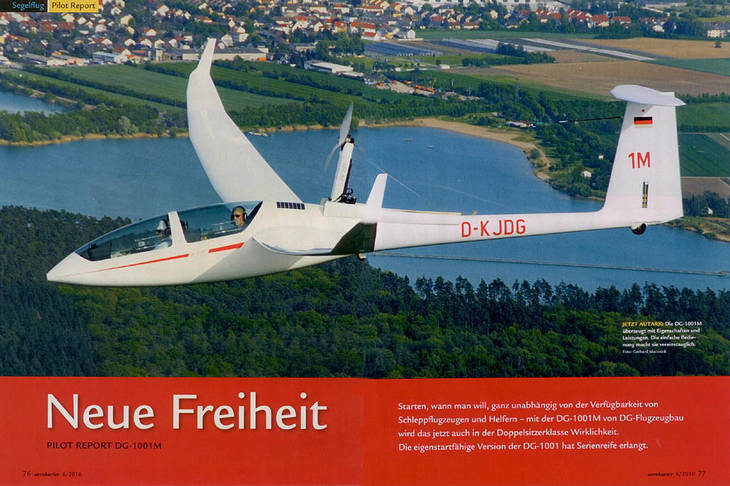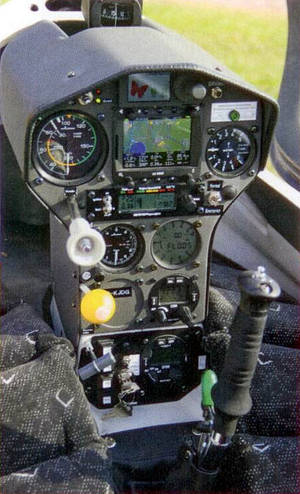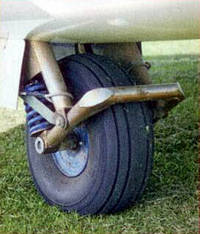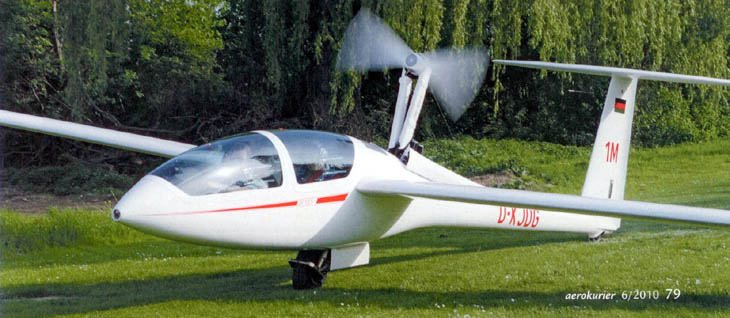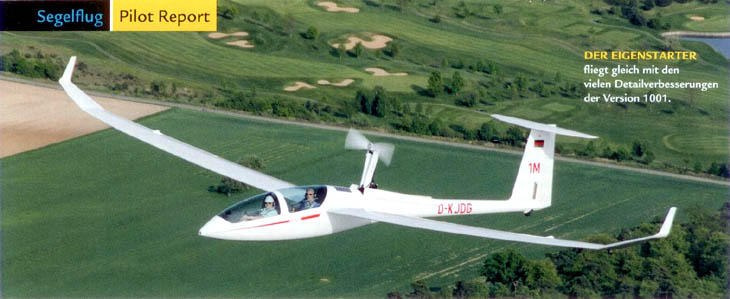Report and Photos by Gerhard Marzinzik in the Aerokurier 6/2010
To take off whenever you want, totally independent of towplane or helpers – with the DG-1001M this is now also a reality in the two seater class.
The Self-Launching Version has achieved production stage.
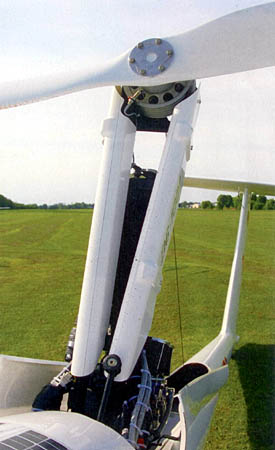 The DG-1000 is already a well known feature on many glider airfields. The glider can also celebrate a small jubilee, for ten years the still modern 20m two seater has been in production.
The DG-1000 is already a well known feature on many glider airfields. The glider can also celebrate a small jubilee, for ten years the still modern 20m two seater has been in production.
Five years ago the first sustainer engined DG1000 was produced. At the same time it was our wish to offer the fans of this sailplane a Self Launcher, but a sufficiently powerful engine was not available. In the meantime SOLO has developed an electronic injection for its 2625 engine which increases the performance to 67 HP.
That this amount of horsepower is more than enough, we proved taking off at Bruchsal on the grass runway. The plane at a weight of 780kg, lifted off the ground after a short take off run and thereafter achieved an excellent climb rate. The plane, with a not completely filled fuel tank and reserves for the cockpit payload (40 kg below its maximum take off weight), lifted off the ground before reaching half the length of the grass runway and continued climbing at 95 km/hr with a climb rate of 2.5m/s.
The engine controls offer the usual DG simplicity. The turn of the ignition key initiates the rising of the mast mounted propeller. Only after the propeller is locked and the propeller stop is released is the start button ready to start the engine. With the, as already used on the DG-808, steerable tail wheel and the small wing wheels was the DG-1001 easily controllable to taxi even on the grass field at Bruchsal. The large spring mounted main wheel absorbs without problems even deep ruts in the surface. The DG-1001M is standard equipped with an electrically operated gear retraction system.
For take off , as advised by the chief designer of DG, Wilhelm Dirks, who accompanied me on this flight, I initiated power gradually to prevent the plane dipping onto its nose. But I could not find any tendency of the plane to tip forward, The DG accelerated rapidly and after a few metres
I could level the wings and the initially fully pulled stick could be relaxed into its neutral position. At a speed of about 80km/hr the plane could be lifted off the ground.
The DG-1001M, trimmed to a speed of 95km/hr continued its climb and turned freely. If one pulls the stick during climb onto its rear stop, the DG does not stall and allows one even in this position to move the controls without breaking away. The plane behaved good natured when an engine failure was simulated. The pilot has in normal climb sufficient time to lower the nose and bring the plane into a normal glide position.
If an engine failure occurs in a critical position just outside the boundary of the airfield which is caused by the electronic injection system a simple procedure restarts the engine. By moving the emergency switch an independent secondary electronic injection system is initiated which restarts the engine.
The engine system is almost vibration free because of a newly developed engine mount. The power transmission and reduction transmission is made using 5 V belts which permit an engine mount similar to the mounts used in power planes. This prevents load reversal back strikes of the propeller.
The slip of the V belt which is used for this on the other hand causes a minimal not measurable performance loss. With the V belt returns at DG a long lost detail: The propeller stopper, which is automatically controlled.
The noise level in the cockpit is in the climb as in level flight within acceptable limits.
During cruising flight, an average speed of 50km/hr can be maintained with reduced power at about 6500 rev/min.
The stopping of the engine and the retraction of the motor mast is controlled with the digital engine control DEI-NT: Power to idling and switching of the ignition initiates the automatic retraction of the system. In case the propeller needs to be moved into the vertical position, this is done by the autogyro effect or by actuating the starter.
During my flight in subtropical airmass and below a cover of cirrus, I had several times the opportunity to practice the re-start and shut off procedure. The engine started on every attempt without problems which is the advantage of the electronic controlled fuel injection. Another advantage of the electronic injection is an always correct fuel mixture. Because of this, the engine always, independent of altitude, develops maximum possible performance.
DG has run the engine in the 1001M about 43 hours until the end of April, an engine time which in normal operation of self launchers is not used over several years. Five minutes are normally sufficient to enter thermals. The high run time performance speaks for the SOLO engine with the injection system which nevertheless still has to be certified.
With the engine stowed the DG-1001M flies like the sailplane, but due to the higher wingloading the minimum speeds are increased. The “M” version has not lost any of its manoeuvrability. The changing cores of the sporadic warm air thermals were easy to follow. A speed of about 90 km/hr was sufficient for medium bank rates.
At steeper bank rates an airspeed of about 100 km/hr is required, as with two persons in the plane the wing loading is between 42 to 44 kg/sq m The M version is fairly forgiving, if pressure on the stick is increased at too low an airspeed it only tends to slide off slightly and immediately recovers as soon as the pressure on the stick is released with only a small height loss.
The DG-1001M with its performance and handling characteristics is a Two Seater which is a pleasure to fly and can certainly be recommended for Club operation.
Gerhard Marzinzik
Translation: Frank Pennauer / CDN

